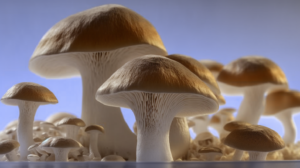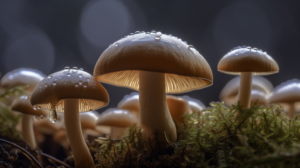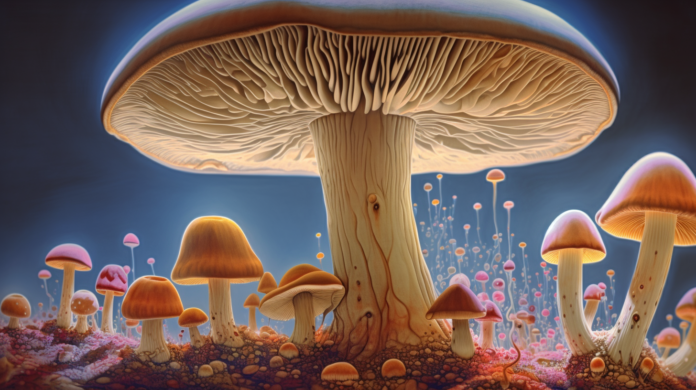At CBD, Weed, & Shrooms, we are dedicated to bringing you the latest and most pertinent information on various mushroom varieties. In this enlightening piece, we will take a deep dive into the captivating realm of the Z-Strain mushroom species, uncovering their distinct characteristics, cultivation methods, and potential advantages. Whether you’re a budding cultivator or an experienced mycophile, this guide will equip you with the knowledge required to successfully cultivate and appreciate the marvels of Z-Strain mushrooms.
Understanding Z-Strain Mushroom
Z-Strain mushrooms, scientifically referred to as Psilocybe cubensis Z-Strain, have gained significant popularity among magic mushroom enthusiasts. As members of the Psilocybe cubensis species, renowned for their widespread availability and relatively uncomplicated cultivation, Z-Strain mushrooms are esteemed for their exceptional potency and unique attributes.
Appearance and Physical Features
Z-Strain mushrooms possess a distinct appearance, characterized by a conical to bell-shaped cap donning an enchanting caramel or golden-brown hue. Typically measuring between 2 to 5 centimeters (0.8 to 2 inches) in diameter, the cap often boasts a prominent nipple-like structure at its center. As these mushrooms mature, their caps gracefully expand and flatten out.
The closely spaced gills of Z-Strain mushrooms begin as white and gradually transform into dark purple or black as the spores develop. The stems, relatively thick in nature, exhibit a whitish or off-white coloration and occasionally display bluish bruising when handled or damaged.

Z-Strain vs Golden Teacher Mushrooms
When it comes to magic mushrooms, two strains often stand out for their unique characteristics: the Z-Strain and the more well-known Golden Teacher strain. Both strains have garnered attention for their potency and cultivation ease, but they offer different experiences and benefits that cater to various preferences and needs.
Z-Strain: The Aggressive Producer
The Z-Strain is renowned for its aggressive mycelial growth and high yield. Originating as a novelty strain from an unknown source, it has become a popular choice among cultivators for its speed from inoculation to harvest. The mushrooms are dense and meaty, often towering over other strains. The Z-Strain is also known for its high potency, offering strong visuals and a euphoric, physical high. It thrives in a substrate mix of compost, grain, and pasteurized dung & straw, and prefers a colonization temperature of 28-30°C and a cropping temperature of 22-25°C.
Golden Teacher: The Mystical Experience
On the other hand, the Golden Teacher offers a more mystical and educational experience. First appearing in the 1980s, this strain has golden caps speckled with yellow and large, elegant stems. It is less abundant in fruit formation compared to the Z-Strain but compensates with its larger size and potency. Golden Teachers are also more particular when it comes to colonization, requiring specific conditions for optimal growth. They thrive in a similar substrate mix but prefer slightly different temperatures for colonization and fruiting, 84-86°F and 74-78°F respectively.
Key Differences
- Potency: Z-Strain is generally considered more potent.
- Yield: Z-Strain produces more mushrooms, while Golden Teacher compensates with larger sizes.
- Growth Speed: Z-Strain colonizes faster.
- Experience: Golden Teacher offers a more mystical and educational trip.
Cultivation: Nurturing Nature’s Treasures
Z-Strain mushrooms are ideally suited for cultivation and can be grown indoors with relative ease. To start on the cultivation process, you will need the following:
- Substrate: Z-Strain mushrooms thrive on a substrate consisting of organic materials such as vermiculite, brown rice flour, and gypsum. This substrate provides the essential nutrients required for the mushrooms’ growth.
- Spores or Spawn: Acquiring a reliable source of Z-Strain spores or spawn is vital. Spores are microscopic reproductive cells, while spawn refers to the mycelium (the vegetative part of the fungus) grown on a substrate. Both can be used to inoculate your substrate.
- Growing Environment: Z-Strain mushrooms flourish under specific growing conditions. The optimal temperature range for their growth is between 21 and 24 degrees Celsius (70 to 75 degrees Fahrenheit). Additionally, they thrive in high-humidity environments, typically around 90% relative humidity, ensuring successful cultivation.
Once you have gathered the necessary materials, follow these steps to cultivate Z-Strain mushrooms:
-
- Thoroughly blend the organic materials to prepare the substrate.
- Sterilize the substrate to eliminate potential contaminants, using a pressure cooker or other sterilization methods.
- Allow the substrate to cool down before introducing the spores or spawn. Using spore syringes, distribute them evenly across the surface of the substrate.
- Incubate the inoculated substrate in a clean and controlled environment with continued support, maintaining the appropriate temperature and humidity levels.
- After a few weeks, the mycelium will have colonized the substrate. At this stage, induce fruiting by adjusting the environmental conditions, which involves lowering the temperature and increasing fresh air exchange.
With proper care and maintenance, you can expect to harvest your Z-Strain mushrooms within a few weeks after inducing fruiting. Harvest them when the veils beneath the caps begin to break, revealing the developing gills.
Potential Benefits and Effects: Exploring Nature’s Enigma
Z-Strain mushrooms, like other strains of Psilocybe cubensis, contain the naturally occurring compounds psilocybin and psilocin. Once ingested, psilocybin is converted to psilocin in the body, which interacts with serotonin receptors in the brain, resulting in a variety of effects. It is crucial to approach the consumption of psilocybin-containing mushrooms responsibly, taking into consideration legal and personal implications.
Psychoactive Properties
Z-Strain mushrooms are revered for their psychoactive properties, capable of inducing a wide range of experiences influenced by dosage, set, and setting. The effects of Z-Strain mushrooms may include altered perception, feelings of euphoria, and long-lasting, euphoric experiences. Users often report changes in sensory perception, heightened colors, intensified patterns, and enhanced auditory experiences.
- Mind Expansion: Z-Strain mushrooms can facilitate introspection, creativity, and a profound sense of interconnectedness. Many individuals describe experiencing profound insights and expanded states of consciousness during their journey.
- Mood Enhancement: Psilocybin has been associated with elevated mood and positive emotional states. It may help alleviate symptoms of anxiety and depression, and promote an overall sense of well-being.
Therapeutic Potential
Beyond their recreational use, Z-Strain mushrooms and other psilocybin-containing mushrooms have garnered attention for their potential therapeutic applications. Research suggests that they may be beneficial in the treatment of various conditions, including:
- Depression and Anxiety: Psilocybin-assisted therapy has shown promise in alleviating symptoms of treatment-resistant depression and anxiety disorders.
- Substance Addiction: Studies indicate that psilocybin may assist individuals in overcoming addiction to substances such as nicotine, alcohol, and opioids.
- End-of-Life Distress: Psilocybin therapy has demonstrated potential in providing psychological and existential support for individuals facing end-of-life distress, particularly in the context of palliative care.
It is important to note that further research is still required to fully comprehend the therapeutic potential and appropriate applications of Z Strain mushroom and psilocybin-based therapies.
The Potency of Z-Strain Mushrooms
Z-Strain mushrooms are known for their exceptional potency. These medium-sized, meaty mushrooms can produce effects due to their high levels of psilocybin, psilocin, and other compounds. The psilocybin typically ranges between 0.63% and 0.90% in these mushrooms. The potency of Z-Strain mushrooms may vary, but they are generally considered to be one of the most aggressive strains available.
Users of Z-Strain mushrooms often report profound psychedelic experiences, such as altered perception and a sense of interconnectedness. However, these effects can vary based on factors like the user’s weight, tolerance, mindset, and environment.
Mushroom Dosage: Finding the Right Balance
To ensure a safe and enjoyable experience with Z Strain mushrooms, it is important to determine the appropriate dosage. The effects of mushrooms can vary from person to person, so it is recommended to start with a low dose of z strain mushroom and gradually increase if desired. A magic mushroom dosage calculator can be a helpful tool in determining the right amount based on factors such as body weight and experience level.

The Legality of Psilocybin Worldwide
The legal status of psilocybin varies across different countries and regions. Here is a brief overview of the legal landscape in the United States and a few other countries:
United States:
- Oregon: In 2020, Oregon passed Measure 109, making it the first state to legalize the regulated medical use of psilocybin.
- Washington, D.C.: In 2020, Washington, D.C. passed Initiative 81, reducing the enforcement of laws against psychedelic plants and fungi to be among the lowest law enforcement priorities.
- Denver, Colorado: In 2019, Denver became the first city in the U.S. to decriminalize psilocybin mushrooms.
- Santa Cruz, California: In 2020, the Santa Cruz City Council passed a resolution that effectively decriminalizes all “entheogenic plants and fungi,” including psilocybin mushrooms.
- Oakland, California: In 2019, Oakland City Council passed a resolution decriminalizing certain natural psychedelics, including psilocybin mushrooms.
- Ann Arbor, Michigan: In 2020, the Ann Arbor City Council declared the investigation and arrest of individuals involved with the use of entheogenic plants, including psilocybin, to be the lowest law enforcement priority.
Canada:
Psilocybin is classified as a Schedule III drug under Canada’s Controlled Drugs and Substances Act. However, in August 2020, the Canadian Minister of Health granted exemptions to terminally ill patients, allowing them to use psilocybin as part of their end-of-life care.
United Kingdom:
Psilocybin is classified as a Class A drug in the UK, making it illegal to possess, produce, or supply.
Netherlands:
Psilocybin mushrooms are illegal in the Netherlands, but “magic truffles,” which are sclerotia containing psilocybin, can be legally purchased from smart shops.
Brazil:
Psilocybin is unregulated in Brazil, and the use of psilocybin-containing mushrooms for religious or spiritual purposes is protected under the constitutional right to religious freedom.
Portugal:
Portugal decriminalized all drugs, including psilocybin, in 2001. Possession of small amounts is considered a public health issue rather than a criminal offense.
Spain:
Psilocybin mushrooms exist in a legal grey area in Spain. While it is illegal to sell or distribute them, personal cultivation and use are generally tolerated.
Mexico:
Psilocybin mushrooms are legal to use in Mexico, protected under laws pertaining to indigenous and religious rights.
Please be aware that the legal status of psilocybin is subject to change, and this information may not be exhaustive. Always consult with a legal professional to understand the laws specific to your location.
Final Thoughts
Z Strain mushrooms, with their captivating appearance, straightforward cultivation process, and intriguing properties, have captivated the hearts of mushroom enthusiasts and researchers alike. Throughout this comprehensive guide, we have explored the distinctive characteristics of Z-Strain mushrooms, their cultivation techniques, potential benefits, and effects. We hope this enlightening article, intended for microscopy and educational reference, has provided you with valuable insights and information, nurturing your understanding of Z-Strain mushrooms. Remember to always approach the subject responsibly and in compliance with the laws of your jurisdiction.
Disclaimer:
The content provided in this article is for informational purposes only and should not be considered medical or legal advice. Always consult with a qualified professional before making any decisions regarding the use or cultivation of mushrooms. The cultivation, possession, or consumption of certain species is illegal in many jurisdictions. This article is intended for informational and educational reference only and is not intended to promote illegal activities or use.


